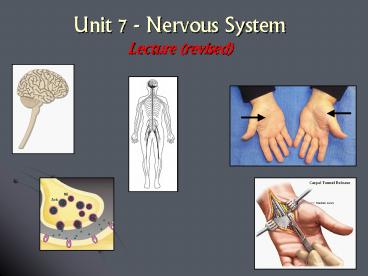Unit 7 Nervous System Lecture revised
1 / 29
Title:
Unit 7 Nervous System Lecture revised
Description:
Carpal Tunnel Syndrome. Entrapment of the median nerve. CTR. Successful Outcomes? ... Carpal Tunnel Release (CTR) Parkinson's Disease. Parkinson's Disease ... –
Number of Views:34
Avg rating:3.0/5.0
Title: Unit 7 Nervous System Lecture revised
1
Unit 7 - Nervous System Lecture (revised)
2
The Nervous System
Introduction
This is a human brain. Can you identify the
defect? What happened? Male or Female? Who is
responsible? E-mail me your answers w/ brief
explanations for points.
Whatever it is, it looks like it hurt. Push
the buttons for an idea about what happened.
3
Nervous System
- Central Nervous System
- Peripheral Nervous System
4
(No Transcript)
5
Nervous System
- Central Nervous System
- Brain
- Spinal Cord
- Peripheral Nervous System
- Nerves/Neurons
- Sensory
- Motor
- Autonomics
- Sympathetic
- Parasympathetic
6
Nervous System
- Central Nervous System
- Brain
- Spinal Cord
7
Nervous System
- Peripheral Nervous System
- Everything Else
- Neurons
- Sensory Neurons
- Motor Neurons
- Autonomics
- Sympathetic
- Parasympathetic
8
NeuronsPeripheral NS
9
A Knife in the Knee
10
Autonomic Nervous SystemProvides Balance
Sympathetics Fight or Flight NE (norepinephrine)
Parasympathetics Feed Breed/Rest
Digest Acetylcholine (Ach)
11
Sympathetic NS
- Reaction
- Fight or Flight
- Example in a dark parking lot one hears ( )
- pulse accelerates
- pupil dilation
- bronchioles dilate
- Neurotransmitter
- Norepinephrine (NE1)
1. Norepinephrine (NE), Epinephrine (Epi), or
Adrenaline
12
Parasympathetic NS
- Reaction
- Rest Digest
- Feed Breed
- slows the heart rate
- increases digestion
- enhances erectile tissues
- Neurotransmitter
- Acetylcholine
13
The Nervous System
Made of Nerves
14
- Neurons
- Carry electrochemical signals
- Are the functional unit of the nervous system
- All neurons have three parts
15
Synapse/NMJ
16
The Neuron
Myelin, a natural insulation, helps increase the
rate of nerve impulse propagation.
The NMJ (Neuro-Muscular Junction)
17
Human Brain Anatomy
Cerebrum (cerebral cortex) Thought Process
Motor Fxn Cerebellum Balance and
Coordination Brainstem Vital Functions (pulse,
respirations, BP)
18
Cerebral Vascular Accident CVA/Stroke
- Strokes are either
- Embolic clots resulting in obstruction
- Hemorrhagic bleeds resulting in disruption of
circulation.
19
Cerebral Vascular AccidentStroke
Embolic
Hemorrhagic
http//images.google.com/imgres?imgurlhttp//rad.
usuhs.mil/medpix/tachy_pics/thumb/synpic16523.jpg
imgrefurlhttp//rad.usuhs.mil/medpix/medpix.html
3Fmode3Dfactoid_images26recnum3D4965h130w10
2sz4hlenstart15tbnidzC65TI2GNO3PKMtbnh8
5tbnw66prev/images3Fq3Dcerebral2Bvascular2
Baccident26svnum3D5026hl3Den26lr3D26safe3D
off26rls3DDVFA,DVFA1970--2,DVFAen26sa3DG
20
AphasiaImpaired production or comprehension of
speech
Brocas Aphasia - Motor Aphasia. Inability to
speak characterized by a deficit in speech
production or language output. The patient is
aware of the impairment, can understand spoken
words and can read.
Wernickes Aphasia - Sensory Aphasia. Inability
to speak because of an impairment in the
comprehension of spoken and written words. There
is effortless, free-flowing speech and writing,
but without any grammar, and it makes no sense.
Wrong words, substitute words, and neologisms
(made up words) are characteristic. The patient
often appears unaware of the deficit.
21
CVA/StrokeFacial Droop
22
Peripheral Nervous System Diseases
Carpal Tunnel Syndrome Entrapment of the median
nerve
23
CTRSuccessful Outcomes?One of the best in
Surgery
Carpal Tunnel Release (CTR)
24
Parkinsons Disease
Parkinson's Disease is often characterized by
muscle rigidity, tremor (pill rolling), and
shuffling gate. Rx Dopamine
25
Myasthenia Gravismuscle-weakness, grave in
nature
MG - a disorder of neuromuscular transmission
marked by fluctuating weakness of skeletal
muscles. Caused by an autoimmune mechanism
whereby Ach receptors are destroyed via immune
modulated response. It is the only disease that
manifests in a Descending Paralysis. Starting at
the top of the head, diplopia usually occurs
first. Symptoms progress downward, affecting the
neck and arms. Ultimately, death or cardiac
arrest occurs as the respiratory muscles
(specifically the diaphragm) are paralyzed.
The Classic Diplopic gaze of MG
26
Myasthenia GravisGrave Muscular Weakness-
Auto-Antibodies are Self-Produced - These
Antibodies are directed specifically toward the
Acetylcholine Receptor- This results in the
blockade of Muscular Contraction- Ultimately
death results from paralysis of respiratory
muscles
27
Thymoma
An Anti-body producing tumor - Produces
Antibodies to the post Synaptic Acetylcholine
Receptor at the NMJ (Neuromuscular Junction)
28
Multiple Sclerosis
A common demyelinating disorder of the central
nervous system, causing patches of sclerosis
(plaques) in the brain and spinal cord. Occurs
primarily in young adults, has variable clinical
manifestations, depending upon the location and
size of the plaque.
Typical Symptoms Weakness Spasticity Numbness
Pain Ataxia Tremor Speech disturbances Diplopic
gaze Bowel/Bladder dysfunction Sexual dysfunction
Depression Cognitive deficits
29
Nervous System DiseaseMultiple Sclerosis - A
Demyelinating Disease
Demyelination
Normal Axon
Multiple Sclerosis
Demyelination































